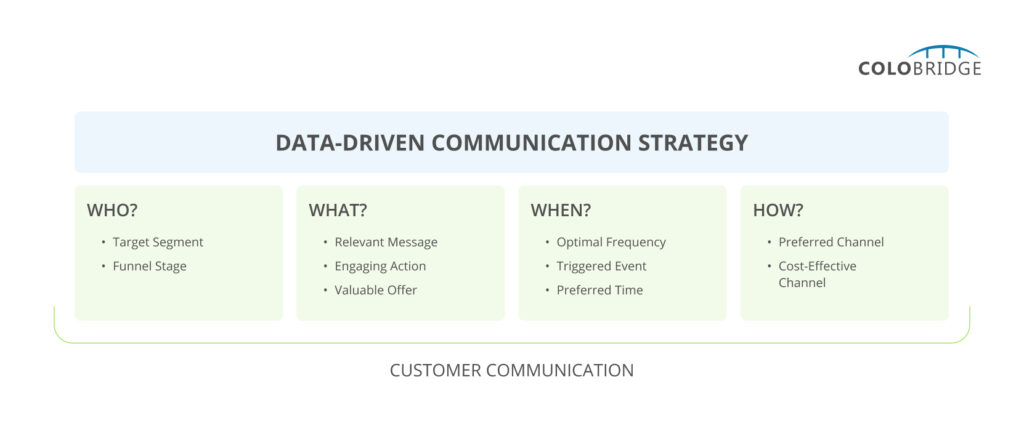Author: Volnyanskyi A.
Cloud platforms provide robust tools for data storage, processing, and analysis, as well as access to infrastructure and tools for developing and deploying machine learning (ML) and artificial intelligence (AI) models. Cloud solutions facilitate easy data exchange between various systems and applications, fully enabling a data-driven approach in business. Here, we explain what this entails and how to implement a communication strategy based on data.
At the core of marketing and sales lies communication with customers. However, since every customer is unique, there are no universal solutions that work in 100% of cases. The simplest way to segment customers is to categorize them based on the stage of their life cycle: some customers are new, others have left the company, and still others make purchases regularly. But to learn more about each customer and make an offer that meets their real needs, traditional segmentation is not enough. In this case, automation and advanced analytics come to the rescue.
Tasks and opportunities of advanced analytics
Every company is interested in improving customer acquisition and retention outcomes, as well as in executing effective cross-selling and upselling. Such processes should proceed in parallel: retaining those who are about to leave while simultaneously motivating others to make more purchases. This is a task with many variables, and one of the ways to address it is by implementing an effective customer communication strategy based on a data-driven approach.
A data-driven approach in marketing means that strategic decisions are made based on data analysis. By adopting this approach, a company can improve communication with customers by offering personalized solutions—matching and even anticipating their desires and needs.

The main benefit of implementing a data-driven approach is that it provides answers to the following questions: who, what, when, and how—that is, which customer should receive which message, when, and through which channel. Let’s explore how advanced analytics tools assist in this process.
Who?
Advanced analytics allows the identification of customer segments that are most profitable, enabling the preparation of personalized offers for these groups.
What?
Personalized messages crafted based on the analysis of micro-segments are designed to resonate with customers and increase their desire to use the company’s products. Calls to action are used to provide additional motivation. It is crucial to craft an offer that is advantageous for the business and appealing to the customer.
When?
Personalized offers should be sent neither too frequently nor too infrequently. The optimal timing is in response to specific trigger events (actions or behaviors of customers). Advanced analytics can help determine the best timing for sending specific messages to maximize engagement.
How?
This aspect concerns the preferred communication channels, as different customers favor different channels. By analyzing data on the capabilities of each communication channel, the most cost-effective channel can be selected.
Data-Driven Approach: Transforming Ideas into Actions
The data obtained through advanced analytics do more than just answer the four questions outlined above. They enable the implementation of solutions in a resource-efficient manner. Every decision will be data-driven, allowing companies to move away from operating blindly based on historical data and intuition. Instead, actions are taken to achieve desired outcomes.
Here’s what can be achieved by implementing a data-driven approach in your business:
- Transforming newcomers into VIP clients by understanding their needs and behaviors.
- Identifying customers who are likely to leave and understanding the reasons behind their departure.
- Beginning to comprehend which customers are best suited for specific product recommendations and much more.
All these insights transform into an effective communication strategy where decisions are made based on well-founded data for each customer micro-segment. This approach not only improves customer relationships but also enhances overall business efficiency and effectiveness.
Colobridge’s Expert:
“Data-driven customer communication leads to a better understanding of the target audience, an increase in the share of loyal customers, a reduction in churn, and an enhancement in the number of cross-sales and upsells. Companies interested in such results should start acting now to gain a competitive advantage in the market ahead of others. Even if a company lacks the necessary infrastructure or team to implement a Data-Driven approach and use artificial intelligence tools, this should not be a barrier. At Colobridge, we offer an AI Engine as a Service solution for marketing tasks, which is available as a fully ready service—this can be deployed either on the client’s infrastructure or on our technology platform.”
To learn more about the AI Engine as a Service product and its capabilities for your business, you can contact the managers at Colobridge.





